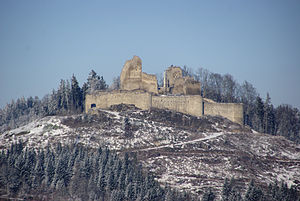Ruttenstein castle ruins
| Ruttenstein castle ruins | ||
|---|---|---|
|
Ruttenstein ruins |
||
| Creation time : | 12th Century | |
| Castle type : | Hilltop castle | |
| Conservation status: | ruin | |
| Place: | Pierbach | |
| Geographical location | 48 ° 22 '42 " N , 14 ° 46' 16" E | |
| Height: | 758 m above sea level A. | |
|
|
||

Ruttenstein castle ruins are the ruins of a hilltop castle about 3.5 km northeast of Pierbach in the Freistadt district in the Mühlviertel in Upper Austria .
location
The extensive complex of the former hilltop castle extends on a wooded mountain cone at 758 m above sea level. A. Elevation above the valley of the Große Naarn in the village of Niederhofstetten, part of the Pierbach community .
Surname
The name (documented: Rotenstein ) probably goes back to a slight reddish color of the granite rock there. The dative use of place names, which was common in the Middle Ages , led to today's contracted place name: (to) red stone - Rotenstein - Ruttenstein.
The interpretation that the castle name derives from the bony fish species Rutte has entered into legends : During a siege , the castle crew is said to have pretended to the enemy that they still had enough food by throwing rods that were kept in a pond over the wall (see below: web link). However, due to the fact that the castle was officially called Rotenstein , this interpretation must be seen as historically incorrect.
description
The walls of the formerly massive pentagonal keep are only preserved in remnants and tower over the complex, tapering to a point and visible from afar. The former residential wing in the west has been preserved on three sides of the wall. A viewing platform was built above them, which is freely accessible via wooden stairs. The early Gothic castle chapel near the stone staircase to the residential building is clearly recognizable, but also only preserved in remnants . The actual main castle was protected to the north, south and east by a mighty curtain wall , some of which is still preserved today , from which seven towers protruded. The total converted area is 4,800 m 2 , that of the main castle 1,600 m 2 .
history
Already on February 14th 1160 a castrum is called Rotenstein . The complex was first mentioned in a document (as Rotensteine ) on January 31, 1209 in one of Duke Leopold VI's. issued certificate to the Baumgartenberg monastery . On May 2, 1281 King Rudolf von Habsburg pledged Ruttenstein, among other goods, to Ulrich II von Kapellen . After the Kapeller family had died out , the castle was given as a fief to the captain ob der Enns Reinprecht II von Walsee, who was married to the daughter Anna of the last Kapeller . In 1483 the Liechtensteiners came into the possession of Ruttenstein as pledges, followed by the Meggauer from 1556 . Leonhard Helfried von Meggau was also the owner of the Greinburg estate from 1621 . In 1615 Ruttenstein was bought by the Meggauer and became their own property until the rule in the 17th century passed to the Dietrichsteiner through inheritance . In 1811 the rulership complex was initially sold to the army supplier Michael Fink from Hainburg , whose goods, including Ruttenstein, were passed on to the dukes of Saxe-Coburg and Gotha in 1823 . The plant is still owned by their descendants today.
As early as 1551 the castle was in disrepair, in 1585 the entire roof was missing, on the engraving by Georg Matthäus Vischer (see above), Ruttenstein was already in ruins.
Todays use
The Ruttensteiner Preservation Association based in Pierbach is responsible for the maintenance of the current ruin. For a few years there has been a restaurant about 10 minutes' walk from the facility, from where guided tours are offered in the summer months. The ruins can be reached from Pierbach via hiking trail no.95, from Mönchdorf via hiking trail no.13. In 2010, the forest south below the ruins was felled. Since then, just as it was when it was used in the Middle Ages, it has been widely visible again.
See also
Image gallery
literature
- Friedrich Schober : Ruttenstein, castle and rule. In: Mühlviertler Heimatblätter . Volume 5, Linz 1965, pp. 213-216 ( online (PDF) in the forum OoeGeschichte.at).
- Herbert E. Baumert, Georg Grüll : Castles and palaces in Upper Austria. Volume 1: Mühlviertel and Linz. Vienna 1988, pp. 126–129.
Web links
- Homepage of the Ruttensteiner Conservation Association
- Entry over Ruttenstein castle ruins to Burgen-Austria
- Ruttenstein at: Burgenkunde.at
- Ruttenstein in a photo gallery at: Burgseite.com
- Friedrich Schober: Ruttenstein (1965) (PDF; 1.3 MB)
- Misinterpretation of the castle name in the legend
- Video: https://www.youtube.com/watch?v=7ZQ0tO7dM70










